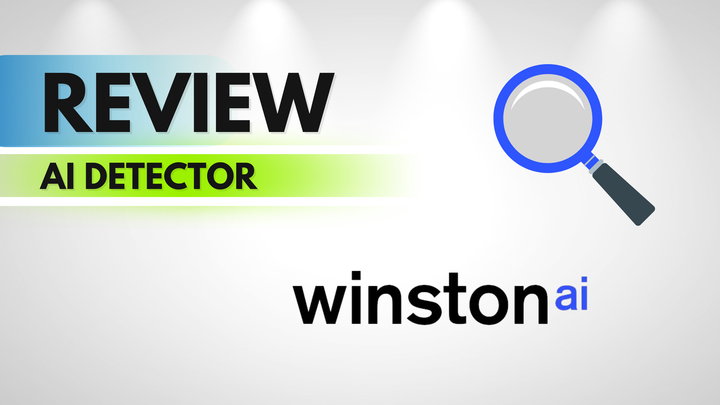7 Best AI Detectors With The Highest Accuracy in 2025
Compare the best AI detectors of 2025 with these breakdowns of their accuracy rates, unique features, and pricing.

AI-generated text is quietly starting to infiltrate our daily lives, which means knowing the best AI detectors matters more than ever. It's especially important when originality counts, like when teachers need to check student assignments or publishers need to assess authenticity. In these situations, having the most accurate AI detector is your best line of defence against AI plagiarism.
According to our research, the top-performing tools this year include GPTZero, Originality.AI, and Winston AI. Each of these tools shines by detecting the subtle linguistic quirks unique to AI-generated content, delivering rapid and reliable insights. To figure out which solution really tops the list, we’ve put their accuracy and ease-of-use to the test, so you can easily see which tools actually work.
Below, we’ll break down the seven best AI detectors out there at the moment, showing you exactly how each tool performs and how they stack up against one another in real-world testing scenarios.
7 Most Accurate AI Content Detectors Compared
To find the most accurate AI detector, we took a number of factors into account, including the accuracy rate, false positive rate, key features and the cost.
7 Best AI Content Checkers Reviewed
Now, let’s take a more in-depth look at some of the top-performing AI detectors available today, taking into account their accuracy rates, as well as their usability and unique features. Whether you’re a teacher, student, editor, or content lead, you’ll get a better sense of what sets each tool apart and how to select the one that best suits your needs.
1. GPTZero – Most Accurate AI Content Detector
GPTZero is consistently rated the most accurate AI detector across various use cases, as confirmed by multiple independent reviews, including TechCrunch, which tested seven other tools before naming GPTZero the best and most reliable. It’s trained on a diverse dataset, independently reviewed by AI and machine learning labs at top institutions.
How does GPTZero work? GPTZero’s model is updated frequently, and its approach involves seven distinct layers, including the 'Burstiness' check, which identifies stylistic variations typical of human writing, as well as a sentence-level highlighting tool that pinpoints and classifies content created through a mix of AI and human input.
Key Features:
- Deep Scan: Offers sentence-level AI detection with color-coded highlights.
- Plagiarism Checker: Cross-checks for content originality.
- Browser Extension: Easy integration with Chrome for immediate scanning.
How accurate is GPTZero? In our tests, GPTZero accurately identified human and AI-generated texts with near-perfect precision. Its accuracy exceeded 99% on pure AI-generated content.
Pricing: GPTZero has a free plan covering 10,000 words per month, with premium plans starting at $12.99/month.
Try out GPTZero for free.
2. Winston AI – Easy for Integrations
Winston AI is handy if you’re already working within platforms like Google Classroom or WordPress. It plugs in easily and offers solid all-around functionality for educators and content managers.
How does Winston AI work? Winston uses a mix of optical character recognition (OCR) and AI models to scan both typed and handwritten content, flagging anything that looks AI-generated. You’ll get detailed scores and feedback for each scan.
Key Features:
- Highlighting AI-generated sentences: Sentences likely generated by AI are visually highlighted and colour-coded, making AI use easily identifiable.
- Free readability score: Instantly evaluate readability with a clear numerical score, including suggestions for improvement.
- Upload large documents: Supports analysis of large documents (including books and scanned files) in .doc and .pdf formats.
How accurate is Winston AI? Generally accurate (around 95%) but sometimes misses the subtleties in more nuanced AI writing.
Pricing: Pricing starts at $12/month for the annual Essential plan, which allows you to scan 80,000 words each month for AI and plagiarism checking.
3. Originality.AI – Suited for Professional Content Teams
Originality.AI offers sophisticated AI detection and plagiarism checks, designed specifically for professional content teams.
How does Originality AI work? Their internally built artificial intelligence uses supervised learning with multiple models, including a modified BERT & Roberta model to predict if it is Human or AI written content. Its AI has been provided with millions of records of both AI and Human text then trained to tell the difference between the two.
Key Features:
- Save time and streamline your workflow: Originality.ai combines AI content detection, plagiarism checking, readability analysis, and fact-checking in one interface, and the features can be switched on or off individually, allowing you to simplify your workflow. The Site Scan feature enables quick scanning of multiple pages simultaneously for efficient content review.
- Strong data protection: Protects user data with industry-standard encryption protocols. Personal information is never shared or sold to third parties. Users can choose whether to allow anonymised data use, with the option to opt out at any time.
How accurate is Originality AI? Very high for pure AI-generated content, however, it sometimes over-flags human writing (accuracy range tends to sit between 76 to 94%).
Pricing: Monthly charges start at $14.95 for the Pro tier with enterprise options available.
4. Smodin – User-friendly for Students
Smodin is geared toward the classroom, is simple to use and includes extra academic tools alongside its AI detection.
How does Smodin work? Scans for structural and linguistic AI markers, especially tuned to catch AI in homework or essays.
Key Features:
- Multilingual support: Detects AI-generated text in over 100 languages.
- Detailed reporting: Offers comprehensive reports highlighting indicators of AI use.
- No account necessary: Users can access the AI checker without creating an account.
How accurate is Smodin? Smodin claims 99% accuracy when analysing human-written content and 91% confidence in detecting text generated by ChatGPT.
Pricing: Offers limited free use, with premium plans starting from around $15/month with an annual subscription.
5. Hive – Specialised Detection for Multimedia
Hive is designed for real-time detection and content moderation, making it ideal for platforms requiring immediate AI identification across vast data streams.
How does Hive work? Hive detects AI-generated images, videos, and deepfakes to help combat misinformation using advanced, automated analysis.
Key Features:
- Single endpoint: Access detection for both AI-generated media and deepfakes through one endpoint.
- Proactive updates: Models are regularly updated to include detection of newly popular generative engines.
- Actionable attribution: Provides confidence scores for AI-generated content and identifies the likely generative engine.
How accurate is Hive? In one study that curated a dataset of 280 real human art images across 7 different styles, and 350 generated AI-based images from generative models using prompts automatically extracted from each of the human art images, Hive produced zero false positives.
Pricing: Custom quotes depending on size and usage.
6. QuillBot AI Detector – Combination Writing Assistance and AI Detector
QuillBot combines its well-known writing assistant with a basic AI detection tool, so it’s useful if you’re already using it to paraphrase or clean up your writing.
How does QuillBot AI work? QuillBot’s AI Detector analyzes text patterns like generic language and consistency of tone to determine whether content is human-written or AI-generated. It uses metrics like perplexity (predictability) and burstiness (sentence-length variation) trained on extensive human- and AI-written texts. When results are uncertain, QuillBot defaults to classifying content as human to reduce false positives.
Key Features:
- Downloadable reports: Detailed PDF reports are available for every analysis.
- Bulk uploads: Review multiple documents simultaneously, identifying specific sections likely written by AI.
- Free access: QuillBot’s AI Detector is free and does not require an account for texts under 1,200 words.
How accurate is QuillBot? Independent tests done by journalists show Quillbot at 80% Accuracy.
Pricing: Free version available; premium starts at $8.33/month through an annual subscription.
7. Grammarly AI Detector – Advanced Real-Time Writing Feedback
Grammarly positions itself as an AI detector from a widely trusted writing assistant. It leverages its existing popularity and user familiarity, making it appealing for those already using Grammarly’s tools.
How does Grammarly AI work? The detection model works by looking at patterns such as syntax and language structure and comparing the text to a larger dataset of both human and AI writing.
Key Features:
- Seamless integration: Integrates with over 500,000 apps and websites, offering real-time writing feedback across platforms.
- User convenience: Ideal for students and professionals needing efficient, immediate writing assistance within their existing workflows.
- Responsible AI ethos: Promotes ethical AI use, emphasising personal autonomy and user empowerment.
How accurate is Grammarly AI? Mixed results (50 to 87%). Grammarly itself says it’s not 100% accurate and it’s better suited for quick guidance than formal checks. While the tool is geared towards minimizing false positives, it states that it “cannot provide a definitive conclusion” and that its “AI detection score is an averaged estimate of the amount of AI-generated text that is likely contained in a given document or piece of writing.”
Pricing: Offers free basic access, with premium features, including enhanced AI assistance and detection, starting from approximately $12/month (when billed annually).
What is an AI Content Detector?
AI content detectors are tools that analyze text to figure out if it was written by a human or an AI system. The tools use algorithms to look at how words are used, how sentences are put together, and what the text actually means – and compare the text to large collections of known AI-generated and human-written content. This helps them spot telltale signs of AI.
In a sense, AI detectors look for the digital fingerprints left behind by machine-written text. Some AI tends to be repetitive or formal, and these clues can help a detector flag potential AI involvement. Such tools are becoming increasingly useful in settings where originality matters, such as education, publishing, recruitment, and journalism.
How Do AI Content Detectors Work?
Many AI content detectors rely on the same techniques AI models like ChatGPT use to create language, including machine learning (ML) and natural language processing (NLP). You can read more here, but as an overview:
Machine learning (ML)
Machine learning is about recognizing patterns – the more text is analyzed, the more easily the tools can pick up the subtle differences between AI-generated and human-generated content. Machine learning drives predictive analysis, which is critical for measuring perplexity (which we’ll get to later) – a key indicator of AI-generated text.
Natural language processing (NLP)
Natural language processing is about the nuances of language, and helps AI detectors gauge the context and syntax of the text it is analyzing. AI can create grammatically correct sentences but tends to struggle with being creative, subtle, and adding depth of meaning (which humans naturally use in their writing).
Classifiers and Embeddings
Within these broad categories of ML and NLP, classifiers and embeddings play important roles in the detection process. Classifiers place text into groups depending on the patterns they have learned: much like teaching someone to sort fruits based on characteristics they’ve learned, but applied to language.
Embeddings represent words or phrases as vectors, which create a ‘map’ of language – this allows AI detectors to analyze semantic coherence.
Methodology: How We Ranked The Top AI Detectors
We put each AI detector to the test with a mixture of human-written and AI-generated text, including outputs from GPT-4, Claude, and Gemini. Our aim was to see how each tool held up in real-world scenarios, specifically from the perspective of educators who are primarily checking student work.
Here are the five key factors we used to rank them:
Highest AI Detection Accuracy
We focused first on how accurately each tool could identify AI-generated text. This was about recognising subtle AI phrasing as well as the more obviously machine-written material.
Lowest False Positive-Rate
An AI detector is only useful if it knows when not to raise the alarm, so we paid close attention to how each tool treated genuine human writing (especially student-style work, which can sometimes mimic AI patterns).
Widest LLM Model Compatibility
Most people are still thinking in terms of ChatGPT, but plenty of other models are in the mix now, and so we noticed which tools were designed to keep up with Claude, Gemini, and open-source models like LLaMA.
Most Advanced AI Detection Technology
Not all detectors are built the same: some rely on surface-level cues, while others dig deeper. We favoured tools that offer transparency about how their detection works, especially those that incorporate multiple layers of analysis.
Use Cases & Extra Features
Finally, we looked at who the tool is really designed for. Some detectors are specifically designed to serve educators while others focus more on enterprise or editorial use.
What Makes GPTZero The Best AI Detector in 2025?
GPTZero goes beyond keeping up with AI and instead is dedicated to helping educators stay one step ahead. These days, where generative AI is everywhere and harder than ever to detect, GPTZero remains the most trusted tool because instead of simply flagging content, it explains the why behind every result.
This is because its sentence-level breakdown is more than a simple score. It shows how each sentence contributes to the overall detection and helps teachers understand the full context behind a result. When you can see the reasoning, you’re better equipped to have a conversation with your students about it.
GPTZero also surfaces the overused phrases and patterns that today’s major AI models tend to generate. This means writers (including students) can learn how to move past generic writing and build a stronger, more distinctive voice.
What really sets GPTZero apart is its commitment to responsible use and its positioning as a classroom ally. Teachers use GPTZero to give real-time feedback and support student learning. The writing feedback tools are built to fit naturally into existing workflows.
Thousands of educators now use GPTZero weekly, and it is backed by a growing community, supported by popular webinars. Importantly, it’s created with student protection at the core: no student data is stored by default, and the platform remains fully FERPA and COPPA compliant.
Test your text instantly with GPTZero for free.
Conclusion
With so many AI detectors now on the market, it can be hard to tell which ones actually work and which just make big claims. After testing them across different models and writing styles, one tool stood out consistently: GPTZero.
This is because it offered the highest accuracy rates in our testing and explained its findings in clear language. It also handled student-style writing without over-flagging. No matter who you are, GPTZero offers both power and clarity in one of the most user-friendly packages out there.
That being said, there are also a number of other tools worth mentioning. Winston AI is great for educators already working in Google Classroom. Originality.AI is strong for professional editorial workflows. And Smodin can be a solid option for students and teachers on a tighter budget.
If you're looking for the most accurate, educator-friendly AI detector in 2025, GPTZero is the one that can help.
FAQs
What is the most accurate AI content detector?
Based on our hands-on testing and comparisons, GPTZero is the most accurate AI detector in 2025. It’s especially reliable across different large language models and student-style writing, with accuracy rates above 99% on pure AI text.
Are AI detectors 100% accurate?
No; and any tool that claims to be probably isn't trustworthy. Even the best detectors have a margin of error. Accuracy typically ranges from 80% to 99%, depending on the type of content and how subtle the AI-generated text is. That’s why human judgment still matters, especially for edge cases.
How accurate is GPTZero?
In our tests, GPTZero achieved over 99% accuracy on pure AI-generated content. It also performed well on hybrid content and was one of the few tools that didn’t over-flag human writing, especially in academic settings.
Why do AI detectors flag my writing?
AI detectors look for patterns common in machine-generated text, like a uniform sentence structure and a lack of variation in complexity. Sometimes, clear or formulaic human writing can get caught in the net, especially if it resembles the patterns AI often uses. This is known as a false positive.
What is the best way to detect AI content?
The best way is to use a reliable tool like GPTZero that breaks down why something was flagged (instead of the fact that it just was). It’s best to look for detectors that offer sentence-level insights and explain their confidence scores, so you’re not left guessing.
What is the most trusted AI detector?
GPTZero has become the go-to for many educators, universities, and publishers as it is ruthlessly transparent about its methods and continually updates to stay ahead of the latest AI models. It’s widely seen as the most trusted AI detector in 2025.
Test your text instantly with GPTZero.


